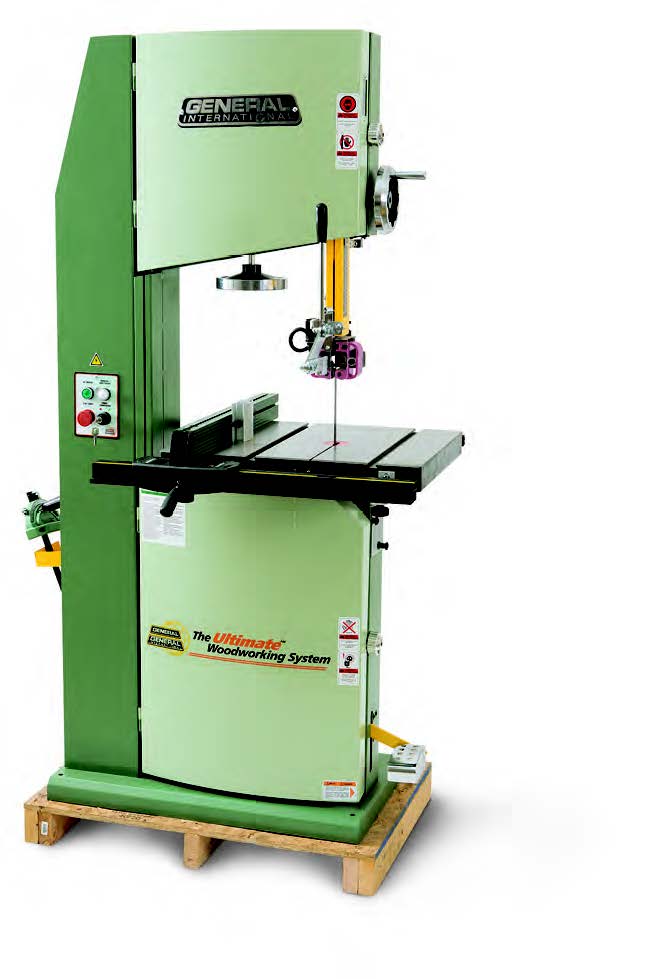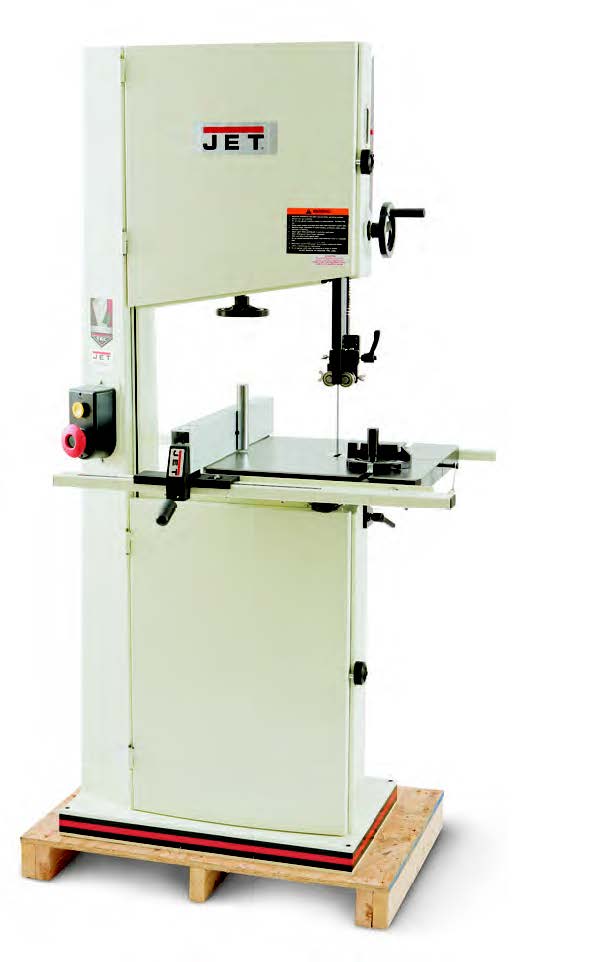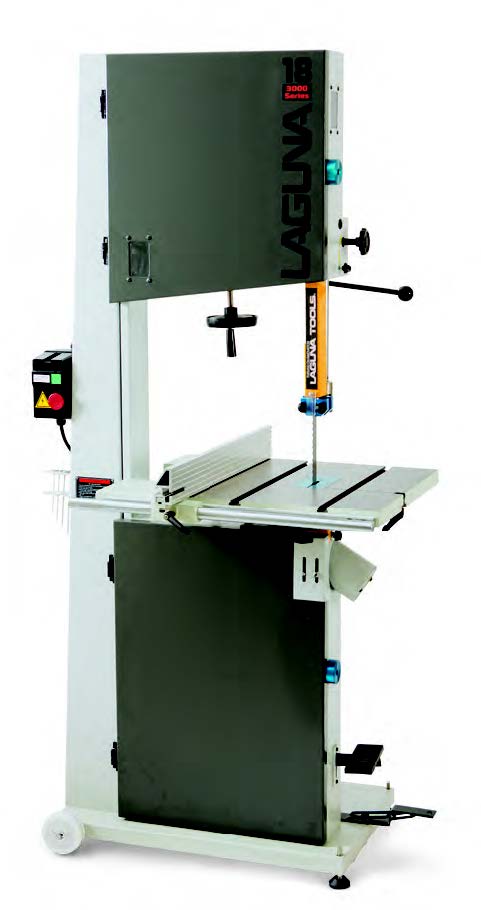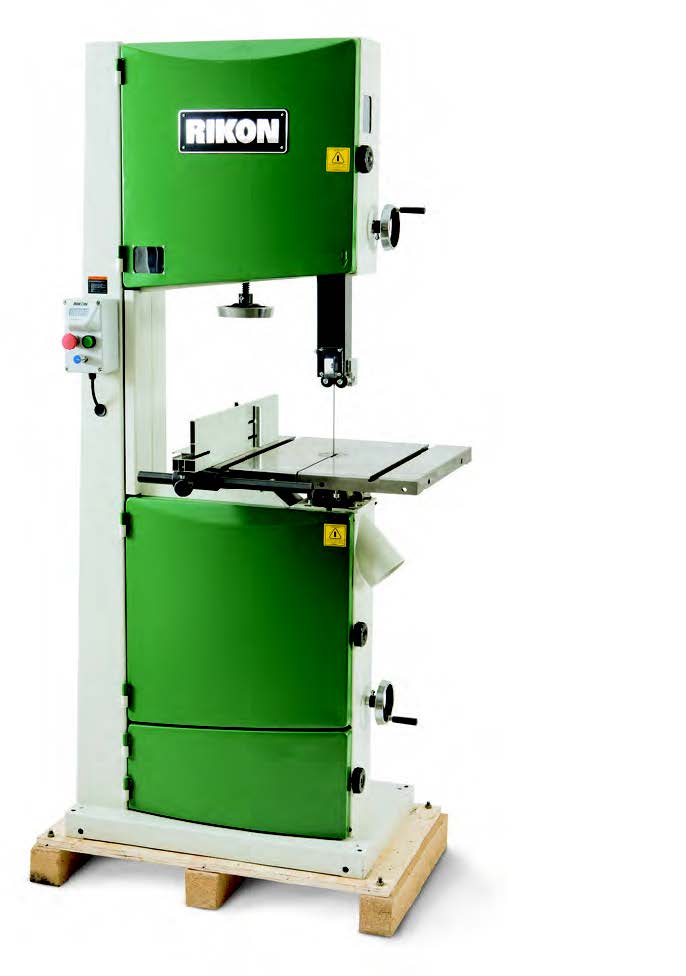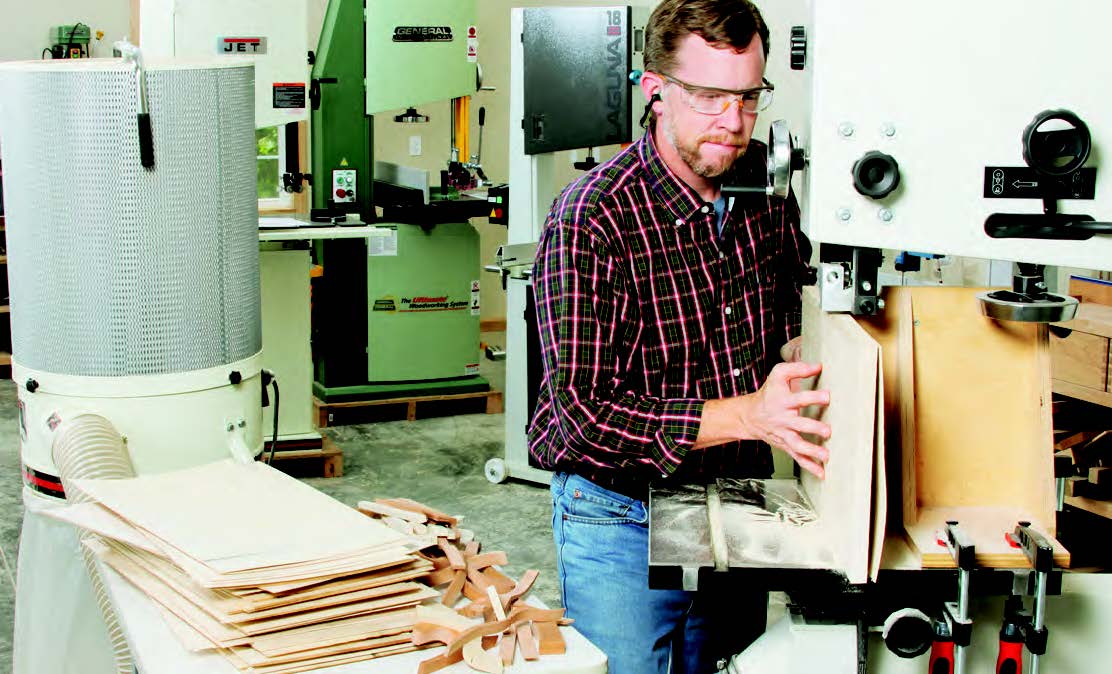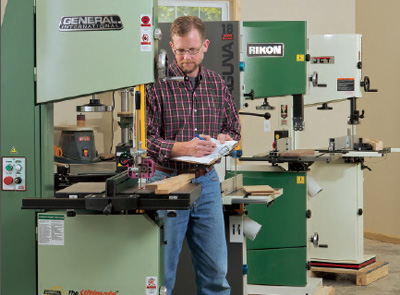
New saw models are also sporting premium blade guides, better fences and big motors to deliver top performance for the dollar.
A decade or so ago, steel-framed band saws were just beginning to catch on here in the States, and at the time, we still called them “European style.” Nowadays, these welded-frame saws have not only become commonplace in manufacturers’ product lines, but it’s hard to even find a new mid-size band saw that still has that familiar rounded cast-iron frame. This evolution in styling is more than just good looks: a steel frame offers tremendous rigidity for tensioning wide blades, and that’s just what you need for carrying out heavy-duty tasks like resawing monster boards or slicing logs into turning rounds.
In the ever-widening ocean of band saw options, I think 18-in. machines represent a good balance of capacity versus cost. Smaller 14-in. steel-framed models may offer similar resawing capabilities for less money, but in my experience they often aren’t outfitted with the same rugged components to form a complete heavy-duty package.
In contrast, these larger machines are designed from the ground up to cut wood all day long, every day. Of course, you can buy even larger 20-in.-plus band saws, but the cost skyrockets. For a home woodworker, these 18-in. saws should be sufficient to check “band saw” off your wish list for good.
Recently, I asked several top manufacturers to provide their latest 18-in. saws for testing. I wanted to look at machines in the 2- to 4-hp range, because that seems to be the “sweet spot” for this saw size. A few weeks later, four saws arrived on skids. Grizzly Industrial was also asked to participate, but their preference was to have me look at a 5hp machine you can see on page 65. It’s one of several 18-in. saws with larger motors, but that was more muscle than I felt many woodworkers might need. Shop Fox was also invited to the test but chose to decline the offer this time. Here’s how this group of four sized up for me after testing.
General International 90-290M1 Band Saw Review
Street Price: $3,089.99
Motor Size: 3hp
Table Size: 24″W x 20″D
Weight: 605 lbs.
Resaw Capacity / Throat Width: 12″ / 17-7⁄8″
Blade Length, Width Range: 145-5⁄8″, 1/4″ to 1-1⁄4″
Web/Phone: www.general.ca / 514-326-1161
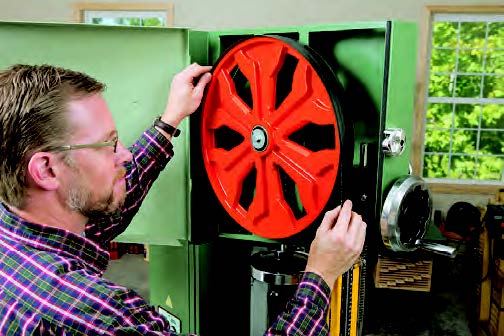
Massive. That’s the first word that came to mind when this saw arrived. Compared to the other three models in this test, it is much larger in stature and heftier. After spending time with this burly saw, it is clear that General designed the 90-290M1 with heavy-duty purpose in mind. For starters, its upper and lower flywheels are made of thicker cast-iron than the other saws. And that added mass helps the motor spin the blade more efficiently through thick, difficult cuts. A foot brake stops the action in seconds. General provides a big, industrial-grade 3hp powerplant; there was no bogging down through the 10 resaw cuts I made in testing. It drove a 3/4″ resaw blade right through poplar with ease. Two 4″ dust ports kept the flywheel cases very clean.
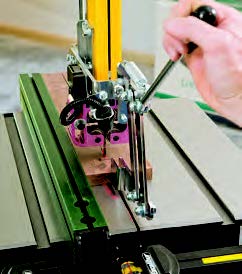
This saw comes with an oversized table for managing big workpieces, plus large hand wheels for tensioning the blade and raising the upper blade guides. Access windows above for blade tracking and below for reaching the lower bearing guide assembly are good, practical features.
Speaking of blade guides, they’re crucial for keeping blades from twisting and to ensure consistent tracking on the wheels. Here, General provides four sets of double bearings beside the blade, on both the upper and lower guide assemblies, plus face-mounted rear thrust bearings, for a total of 10 points of contact on wide blades. While the side guides are easy to unlock and very accessible, their aluminum mounting blocks both adjust and secure with single Allen screws. I find guides that separate fine adjustment from the locking mechanism are a little less fussy to tune up than these.
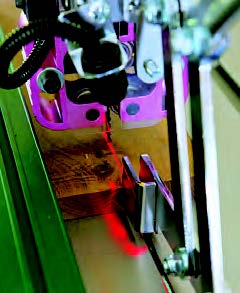
“Big Green” comes with an Excalibur rip fence that adjusts left and right for blade drift — a tendency that, without adjustment, can lead to inaccurate rip cutting. Magnified index cursors and bright yellow scales make setups easy. The fence pops quickly off the rails and stows on the saw. One little gripe: I wish the front rail didn’t have to be loosened and slid clear of the table slit for blade changes, then reset again.
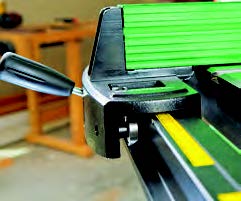
You also get a full-size miter gauge, a tall laminated fence facing and a resawing accessory. There’s a laser for lining up cuts and a unique pushing arm for feeding the tail ends of boards more safely during ripping. But the arm has enough side-to-side play that I would fear cutting into its foot at some point. The laser/feed arm combo also crowds line of sight to the blade. I’d rather have an LED task light than these extras. My verdict here: the 90-290M1 is a strong choice for ambitious sawing, and I doubt it would disappoint a demanding user. But its price tag of just over $3,000 will challenge a modest budget.
JET JWBS-18QT-3 Band Saw Review
Street Price: $1,899.99
Motor Size: 3hp
Table Size: 19″W x 19″D
Weight: 381 lbs.
Resaw Capacity / Throat Width: 12″ / 18-3⁄8″
Blade Length, Width Range: 137″, 1/8″ to 1-1⁄2″
Web/Phone: www.jettools.com / 800-274-6848
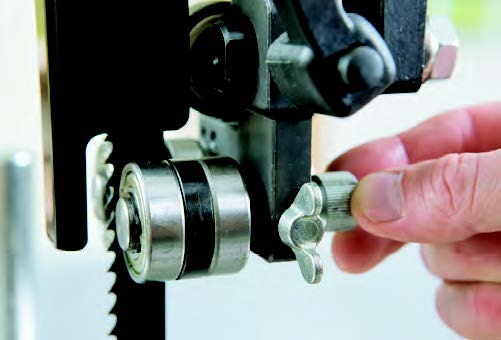
Without question, my favorite feature of JET’s 3hp machine is one that doesn’t catch your eye at first glance: the blade guides. But if you change blades frequently, I bet you’ll appreciate them quickly, too. The doubled-up side bearings have eccentric adjusters. Just twist their knurled knobs to move the bearings away or up close to the blade for final tuning. A wingnut locks their settings without a wrench. The rear thrust bearings are oriented so the blade spine runs against the curved edge — a better design for durability than those where the blade rubs the bearing’s face.
Lower blade guides can be hard to reach under the tables of some saws if you have large hands, but JET’s are uncluttered, and a hinged guard improves access further. Even the machine’s white paint helps to brighten this often shadowy tool area.
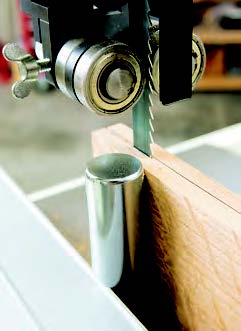
The top blade guide post rolls smoothly up and down on a rack-and-pinion gear, and a three-position quick release lever behind the upper housing allows you to engage full or partial tension or release it entirely. It’s slick for faster blade setups. Dialing in the recommended blade tension for a range of sizes is also easy with the help of a large hand wheel and two scales: one inside and one outside the flywheel case. JET should switch the tracking control from a small star knob to a larger hand wheel, because you’ll reach for it with some frequency. But it does the job. A helpful window on the side of the upper case lets you peek in to check blade position, and the white rubber tire really improves visibility here.
JET has engineered the saw frame with a triangular spine, for purportedly more rigidity. A large “bump” style kill button is mounted to it so that you can activate it without looking. A foot brake, similar to other saws, would add even more safety, but it’s absent.
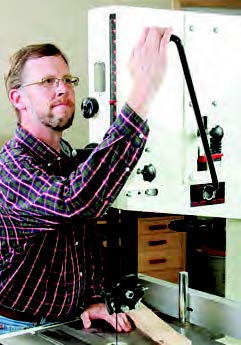
You get a sturdy T-square style rip fence that locks securely to its rail, plus a steel resawing bar and a miter gauge. Sensible table features.
In testing, this saw’s single 4″ dust port was sufficient to keep the lower flywheel compartment almost free of sawdust, and I’ll admit I was surprised, given that the rest of the saws have a second 4″ dust port, too. When resawing, the motor and power train were up to task, although there was some rhythmic vibration that developed. It didn’t impact cutting performance or seem annoying. Line-ofsight to the blade was OK, but there’s a tab on the bottom of the saw’s upper blade guard that makes a tall guy like me have to bend forward to see exactly where I’m cutting.
All in all, I’m pleased with this JET’s test drive, and at just shy of $1,900, I think it’s a good bargain for the price.
Laguna LT18 3000 Series Band Saw Review
Street Price: $2,195
Motor Size: 4hp
Table Size: 20″W x 20″D
Weight: 525 lbs
Resaw Capacity / Throat Width: 15-1⁄4″ / 17-1⁄2″
Blade Length, Width Range: 146″, 1/16″ to 1-1⁄4″
Web/Phone: www.lagunatools.com / 800-234-1976
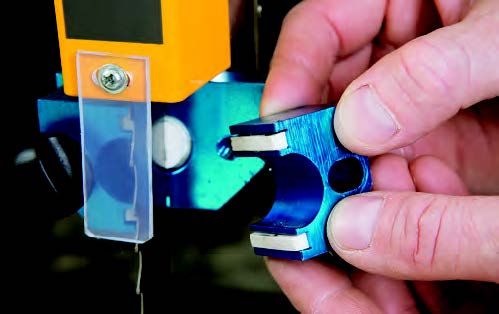
Laguna’s line of 3000 Series saws were introduced a couple of years ago as a more affordable alternative to the company’s other European-made saws, which they still offer. These new 3000 saws originate from the Pacific Rim, just as the rest of the test group models do.
This newcomer delivered admirable performance in my cutting trials. That, in part, is due to its 4-hp Leeson motor, thick cast-iron flywheels for substantial rotational mass and an impressive carbide tooth 1-1⁄4″ Resaw King blade the company provided. Notice that this saw bests the others for potential resaw capacity at a whopping 15-1⁄4″. The veneer I sliced was consistently thick and smooth, and the blade cut it like butter. I only recovered a handful of dust from the lower housing after resawing was done — a bit more than others, but still very tidy.
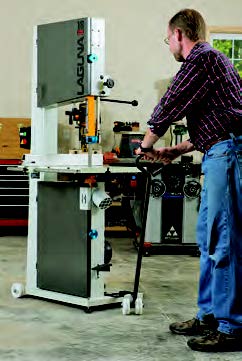
Laguna equips this saw with its signature ceramic blade guides that help to keep the blade running cool during sawing and wear slowly over time. Two ceramic strips support the blade on each side, and a round puck serves as rear support. The guides are mounted in aluminum blocks that adjust laterally and tighten with a single thumb screw. The design doesn’t provide the same fine-setting control as eccentric adjusters, and the bottom inside left guide’s screw was hard to reach. But once they’re set, these ceramic guides work really well.
A quick-release lever takes tension off the blade between uses — a helpful and increasingly common feature these days. There’s a “tension” scale of sorts inside the flywheel housing, but it’s just a swoosh shape with no blade size references on it. A red pointer provides some feedback, but you’ll have to experiment on your own to find optimal tension. To change the blade’s position on the upper wheel, you twist a small star knob. As with the JET, I wish this control was a bigger hand wheel.
I’m happy the machine has a foot brake to stop cuts quickly when you need to.
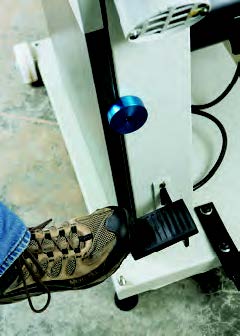
The trunnions that support the LT18’s cast-iron table are beefy, and a geared knob tips the table for making bevel cuts. It’s assisted by a gas-charged shock. Blades load fairly easily from a side table slit. Laguna sent me a mobility kit, which includes an axle, plastic wheels and a “rolling” handle that engages a hitch on the saw base. Of course, you can put an aftermarket rolling base under any band saw, but I like Laguna’s integrated approach. I’ve used this system on my own Laguna band saw for many years.
The LT18 comes with an aluminum rip fence that adjusts for drift and a tubular front rail. You can switch the fence body between an upright orientation for taller support or a “low” position for cutting thin stock. One fussy point about it: you have to loosen the fence body on the clamp with an Allen wrench and slide it back in order to take the fence off the front rail. Lift-off fences are more convenient; you’ll want that fence to come off sooner or later to free up more room when cutting large parts.
At the end of the day, this Laguna is a powerful wood cutter with some nice details. There are no extra frills, but it should prove to be a workhorse and a good reflection of Laguna’s band saw heritage.
RIKON 10-370 Band Saw Review
Street Price: $2,499.99
Motor Size: 2-1⁄2hp
Table Size: 21″W x 19″D
Weight: 400 lbs.
Resaw Capacity / Throat Width: 12″ / 18-3⁄8″
Blade Length, Width Range: 142″, 1/4″ to 1-1⁄4″
Web/Phone: www.rikontools.com / 877-884-5167
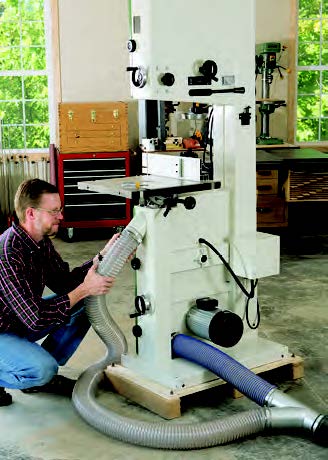
RIKON has reported that they’ve been selling a lot of band saws lately. So, when I requested an 18″ machine, they were temporarily out of stock on their 10-345 model ($1,499.99), which is intended for woodworking. Instead, they sent me the 10-370. It has a sophisticated variable-frequency drive that activates a motor brake for safety and gives you infinite control over two speed ranges: either 82 to 1,312 or 328 to 3,280 feet per minute (FPM). Variable-speed control allows you to cut metal, plastics and composites as well as wood for maximum versatility.
The saw is well-appointed with good features: double ball bearing side guides and edge-mounted thrust bearings, large hand wheels for setting blade tension and adjusting tracking, a quick-release blade tension lever in back, and a legible tensioning scale with a viewing window to assist the process. Two dust ports keep the lower compartment free of all but a dusting of debris, and the table has a geared control for tipping it off of 90°.
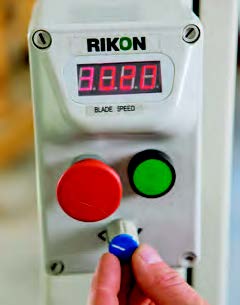
The hinged upper blade guard and front-mounted table slit gave this saw a leg up for me in terms of easy blade changes. Thanks to bright yellow flywheel tires and a viewing window, you won’t have trouble seeing how your blades are tracking, either.
For resawing, the machine comes with a 4-1⁄4″-tall rip fence and a resawing bar. Even though this fence doesn’t lift free of its tubular front rail, just slide it left and off it comes. Simple enough. If you need to pivot the fence to compensate for blade drift, there are long, threaded posts on the front rail. Readjusting the nuts on those posts will skew the fence to some degree by changing the rail’s parallelism to the table.
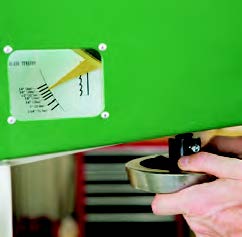
Unfortunately, when I mounted a 3/4″ blade and started resawing, it was quickly clear that something was amiss. The motor labored with even light feed pressure. I called RIKON’s tech support, who assisted in evaluating and diagnosing the problem. As it turns out, the motor had a wiring issue that prevented it from developing full power, but that presented no danger. I corrected the situation with RIKON’s help, and then the motor performed normally. Resawing, even against firm feed pressure, was steady and sure, with no significant drop in FPM. In fact, I watched the digital readout from time to time to confirm it. RIKON assures me that all of its inventory of 10-370 saws are being re-inspected so that this wiring problem won’t happen for you, too.
If you need a saw that’s designed for cutting a variety of materials, take a closer look at this offering. Or, try out the 10-345 model for wood; its competitive price could make it a good buy.
18-inch Band Saw Review Wrap-up
These late-model saws are distinctive but offered fairly consistent cutting performance. So what separates them qualitatively for me are their individual features and price. For my vote, JET’s JWBS-18QT-3 has a winning combination: it’s moderately priced and yet well-conceived for routine blade setups, user convenience and hard work.
